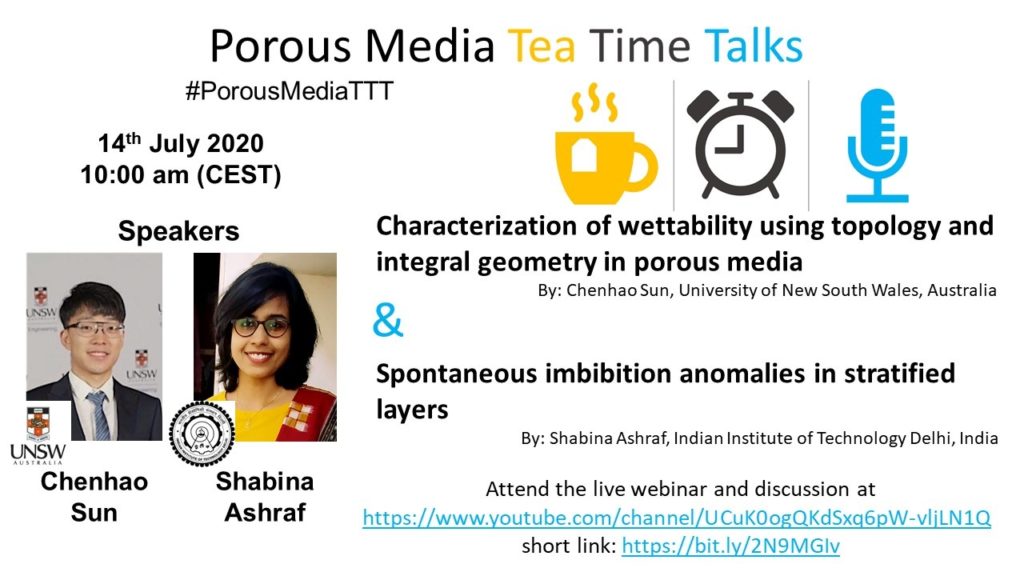After the successful launch of our new webinar series Porous Media Tea Time Talks (#PorousMediaTTT) I am happy to invite you to our second session tomorrow, 14.07.2020 at 10.30 am Oslo time (CEST) / local time on: https://www.youtube.com/channel/UCuK0ogQKdSxq6pW-vljLN1Q.
You are welcome to send questions anytime during the talks using the comment field on YouTube. The presentations will remain online on the channel. I won’t be chairing the session tomorrow, but I’m sure the chairs will appreciate your participation, particularly that of the early career folks.
The two presentation are (banner attached, notice the correct time is 10:30):
Characterization of wettability using topology and integral geometry in porous media
By: Chenhao Sun, University of New South Wales, Australia
- Interfacial phenomena play a central role in numerous natural and technological systems on a daily basis as well as industrial and military applications. In this talk, a topological interpretation for the wetting state of the multiphase system is introduced and the derived general relationship that holds for any system. The topological relationships can be used to derive the macroscopic contact angles and the approach succeeds in situations where the solid geometry domain is complex and confined such as heterogeneous porous medium.
- This topological description is linked with thermodynamics and it is able to capture the effects due to interface dynamics, surface roughness and chemical heterogeneity.
- The developed approach is less sensitive due to gridding and voxelization effects, which could be considered as a robust and consistent method for wettability characterization in complex multiphase systems.
and
Spontaneous imbibition anomalies in stratified layers
By: Shabina Ashraf, Indian Institute of Technology Delhi, India
- For a two-layered porous system, spontaneous imbibition is faster in the layer having large capillary pressure.
- For a multi-layered stratified porous media, the generalized model predicts that the invasion can be faster in a layer having a lower capillary pressure which was also verified experimentally.
- The arrangement of the layers and the contrast in layers’ properties play a significant role in the impregnation dynamics of a stratified porous medium which impact the layer having the leading front and the breakthrough time.
I think those presentations are quite relevant to some of the activity in our group. In particular, I think the work in the first talk may be important to those of you in Trondheim working on topological measures of multiphasic flows, Minkowski functionals and such.
The goal of the Porous Media TTT is to act as a complimentary platform to the already very successful Geoscience and Geoenergy webinars with the focus placed on young professionals.
This year is bringing in many new challenges to the worldwide porous media community, and those challenges can be particularly harsh against those of us at an early career stage. As conferences worldwide are being cancelled or postponed, many of us are found with little practical outlet to advertise our recent work and interact with the broader scientific community. With that in mind, we, a team of 5 young porous media researchers from 5 different groups, have decided to create a virtual outlet, the Porous Media Tea Time Talks to help fill in that gap in form of a regular webinar.
The 30 min webinar, including two presentations (2 x 10 + 5 min) from speakers of different institutes, will occur fortnightly at varying times to accommodate researchers from around the world.
Please feel free to share and forward the invite.
We are very much looking forward to seeing you online!
Best wishes,
Marcel Moura on behalf of the PorousMediaTTT team:
Maja Rücker, Imperial College London, UK
Kamaljit Singh, Heriot-Watt University, UK
Tom Bultreys, Ghent University, Belgium
Mohammad Nooraiepour, University of Oslo, Norway
Marcel Moura, PoreLab, University of Oslo, Norway

